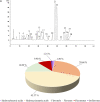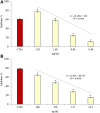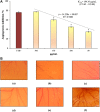Antioxidant, Anti-Inflammatory and Anti-Angiogenic Properties of Citrus lumia Juice
- PMID: 33343362
- PMCID: PMC7744484
- DOI: 10.3389/fphar.2020.593506
Antioxidant, Anti-Inflammatory and Anti-Angiogenic Properties of Citrus lumia Juice
Abstract
Citrus juices are a rich source of bioactive compounds with various and well-known health benefits. The aim of this study was to investigate the polyphenols and ascorbic acid content as well as to investigate the antioxidant, anti-inflammatory and anti-angiogenic properties of the juice of an ancient Mediterranean species, Citrus lumia Risso (CLJ). The antioxidant and anti-inflammatory activities were evaluated by several in vitro cell-free and cell-based assays, whereas two different in vivo models, the chick chorioallantoic membrane (CAM) and the zebrafish embryos, were used to characterize the anti-angiogenic properties. Twenty-eight polyphenols were identified by RP-LC-DAD-ESI-MS analysis (flavonoids 68.82% and phenolic acids 31.18%) with 1-caffeoyl-5-feruloylquinic acid and kaempferol 3'-rhamnoside, which represent the most abundant compounds (25.70 and 23.12%, respectively). HPLC-DAD analysis showed a high ascorbic acid content (352 mg/kg of CLJ), which contributes with polyphenols to the marked and dose-dependent antioxidant and anti-inflammatory properties observed. CLJ showed strong and dose-dependent anti-angiogenic activity as highlighted by the inhibition of blood vessel formation on CAMs and the decrease of endogenous alkaline phosphatase on zebrafish embryos. Moreover, within the concentration range tested, no dead or malformed embryos were recorded. Certainly, further studies are needed to investigate the molecular mechanisms underlying these promising biological effects, but considering the evidence of the present study, the use of CLJ as a ready-to drink safe prevention strategy for inflammatory-based diseases correlated to angiogenesis could be justified.
Keywords: anti-angiogenic; anti-inflammatory; antioxidant; ascorbic acid; chick chorioallantoic membrane; citrus juice; polyphenols; zebrafish embryos.
Copyright © 2020 Smeriglio, Denaro, D’Angelo, Germanò and Trombetta.
Conflict of interest statement
The authors declare that the research was conducted in the absence of any commercial or financial relationships that could be construed as a potential conflict of interest.
Figures






Similar articles
-
Antioxidant and cytoprotective activities of an ancient Mediterranean citrus (Citrus lumia Risso) albedo extract: Microscopic observations and polyphenol characterization.Food Chem. 2019 May 1;279:347-355. doi: 10.1016/j.foodchem.2018.11.138. Epub 2018 Dec 12. Food Chem. 2019. PMID: 30611500
-
Antioxidant and In Vitro Hepatoprotective Activities of a Polyphenol-Rich Fraction from the Peel of Citrus lumia Risso (Rutaceae).Plants (Basel). 2025 Apr 15;14(8):1209. doi: 10.3390/plants14081209. Plants (Basel). 2025. PMID: 40284097 Free PMC article.
-
New Insights on Phytochemical Features and Biological Properties of Alnus glutinosa Stem Bark.Plants (Basel). 2022 Sep 23;11(19):2499. doi: 10.3390/plants11192499. Plants (Basel). 2022. PMID: 36235365 Free PMC article.
-
Potential Anti-inflammatory Effects of Hesperidin from the Genus Citrus.Curr Med Chem. 2018;25(37):4929-4945. doi: 10.2174/0929867324666170718104412. Curr Med Chem. 2018. PMID: 28721824 Review.
-
Vitamin C and the role of citrus juices as functional food.Nat Prod Commun. 2009 May;4(5):677-700. Nat Prod Commun. 2009. PMID: 19445318 Review.
Cited by
-
Antioxidant-Enriched Diet on Oxidative Stress and Inflammation Gene Expression: A Randomized Controlled Trial.Genes (Basel). 2023 Jan 13;14(1):206. doi: 10.3390/genes14010206. Genes (Basel). 2023. PMID: 36672947 Free PMC article. Clinical Trial.
-
Anti-Inflammatory Activity of Mulberry Leaf Flavonoids In Vitro and In Vivo.Int J Mol Sci. 2022 Jul 12;23(14):7694. doi: 10.3390/ijms23147694. Int J Mol Sci. 2022. PMID: 35887036 Free PMC article.
-
Antioxidant and Anticancer Potential of Bioactive Compounds from Rhinacanthus nasutus Cell Suspension Culture.Plants (Basel). 2022 Jul 30;11(15):1994. doi: 10.3390/plants11151994. Plants (Basel). 2022. PMID: 35956472 Free PMC article.
-
Evaluating citrus juice: A comparative study of physicochemical, nutraceutical, antioxidant, and antimicrobial properties of citrus juices from Nepal.Heliyon. 2024 Nov 29;10(23):e40773. doi: 10.1016/j.heliyon.2024.e40773. eCollection 2024 Dec 15. Heliyon. 2024. PMID: 39687093 Free PMC article.
-
A Comparative Study of the Chemical Composition by SPME-GC/MS and Antiradical Activity of Less Common Citrus Species.Molecules. 2021 Sep 4;26(17):5378. doi: 10.3390/molecules26175378. Molecules. 2021. PMID: 34500811 Free PMC article.
References
-
- Bazzicalupo M., Burlando B., Denaro M., Barreca D., Trombetta D., Smeriglio A., et al. (2019). Polyphenol characterization and skin-preserving properties of hydroalcoholic flower extract from Himantoglossum robertianum (orchidaceae). Plants 8 (11), 502–515. 10.3390/plants8110502 - DOI - PMC - PubMed
LinkOut - more resources
Full Text Sources

